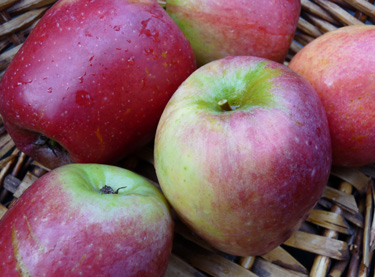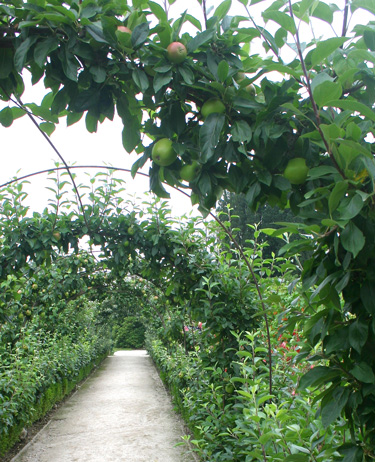7 ways to grow apples in a small garden
The fresher the fruit, the crunchier, sweeter and more nutritious it is. The best way to eat an apple is straight from the tree. Autumn and winter are the very best seasons to plant a new apple tree.
Our gardens are getting smaller but that hasn’t stopped homeowners investing in fruit trees. Nurseries report that fruit tree sales have never been better as more and more of us opt for growing our own. It helps that we have the best ever choice of compact easy-care varieties than ever before, but we’re also re-learning some space saving techniques that have been around for centuries.
Just like the essential lemon tree, apples deserve a place in every backyard. One little apple tree gives huge bang for your buck.
| 1 | Dwarf trees A dwarf fruit tree is a small tree that bears loads of normal sized fruit. Some dwarf trees are small because a compact growth habit is in their genes. ‘Blush Babe’ and ‘Roy's Pearl’ are good examples. More often though, size is restricted because the tree is grafted onto a special ‘dwarfing’ rootstock. The rootstock number should be on the label next to the variety name. M9 is the most common dwarf rootstock that will keep the tree at 2 or 3 metres tall. Dwarf trees are what you might call precocious; most bear fruit at a young age. This, coupled with the fact that more trees can be fitted into a space, makes them popular for large gardens and commercial orchards too. Because dwarf trees don’t grow very tall, all the fruit is easily reached without tall ladders - and we can enjoy all that fruit and blossom at eye level. In a town-sized garden where there was once only room for one larger apple tree, there may be room for two or three dwarf trees of different varieties, which improves pollination. If early, mid and late season varieties are chosen, the harvest season is longer. Dwarf trees are very efficient, using more of their nutrients to produce fruit rather than wood. And they live for many years; it’s nice to think that the tree you plant today may be feeding future grandchildren. |
| 2 | Super slim The now well-known Ballerina (columnar) apple trees were introduced in the nineties, for the first time offering us the ability to grow a fruiting column. They are natural habit is tall and narrow with masses of apples born on very short branches close to the main trunk. Making the most of vertical space, they’re easy to care for and require almost no pruning. They are fantastic for growing in containers, in the middle of a vege or flower bed, or as a row along a driveway or fence. They can also be trained over an archway. Under-plant them with your favourite flowers, herbs, veges, or strawberries. Ballerina apples will support an abundant harvest as early as two years after planting. |
| 3 | Double and triple grafted When there is space for only one tree, how convenient to have two or three different varieties all on one tree. Triple or double grafted varieties are available from garden centres. These specially grafted trees have compatible varieties that grow happily together on one tree, without one out-competing the other. |
| 4 | Espalier apples Espaliering is the age-old art of growing fruit trees in a two-dimensional space along a sturdy wire frame or against a wall. It is not only extremely decorative but very practical too. It’s a great way to grow a lot of fruit in a small space and ensures plenty of sunlight reaches the fruiting parts of the tree, enhancing yields and ripening. Creating and maintaining an espalier requires more training and pruning than a regular tree, but it’s easy work with the secateurs and very satisfying if you have the time. Dwarf trees, because they grow less vigorously, are ideal for the purpose. |
| 5 | Stepover apples The ‘stepover’ is a charming old fashioned technique whereby apples grown in a low fence, traditionally as a border to a potager or flower garden. The principal is the same as for espaliering, but rather than being three of four tiers tall, a stepover is just one layer of horizontal branches. |
| 6 | Apples in containers Dwarf and ballerina apple trees are ideal for growing in large tubs or pots. Plastic pots, because they hold their water for longer, are generally a better option than porous terracotta or concrete pots. Fill the pots with a high-quality potting mix and remain extra attentive to both watering and feeding. Apply controlled release fertiliser in spring and autumn. Growing a precious tree in a container is a good option if you want to take your trees with you when you move house. They can also be extremely decorative and you can enjoy their colour and fragrance on a patio. |
| 7 | Multipurpose If your garden only has space for just one feature tree, why not make it an apple tree? As ornamental as they are productive, apple trees offer summer shade, fragrant spring blossom, a habitat for birds and bees and autumn colours. And they drop their leaves so the sun will get through in winter. If you want a tree you can sit under, choose a regular sized tree that will grow to three or four metres tall and train it to the desired shape, removing lower branches. For help choosing the right apple varieties for your garden, or to find out about the different ways of growing them, check out Waimea Nurseries’ excellent website, www.waimeanurseries.co.nz |
How to grow apples
Growing apples is easier than most people think. Once your tree is planted in the right spot and gets off to a healthy start, there is little else you need to do to enjoy your own fresh apples, year after year after year.
Choose the right spot
Plant your apple tree where it gets as much sun as possible and in good well-drained soil. Avoid areas where the water puddles and don’t plant too close to larger trees.
Choose the right variety
It’s well worth investing time choosing the varieties to suit your needs. If you have room for more than one tree, choosing two complementary varieties will improve pollination, although many varieties are self-fertile. If you live in a humid wet-summer climate, look for the most disease resistant varieties.
Plant with love
Dig a planting hole that is twice as wide, but the same depth as the root ball of your new tree. Add some slow release fertiliser and position your tree in the centre of the hole then carefully replace the soil, firming it down as you go. Water thoroughly and add a layer of mulch. Stakes or espalier supports should be in place before you plant to avoid damaging the tree later. Young trees are generally best given some support while they get their roots established, particularly if exposed to wind.
Food and water
Some watering will be needed in the first few summers to ensure the soil doesn’t become dry, as water stressed trees will grow poorly and produce less fruit. Mature trees with far reaching roots grow surprisingly well without watering. In hot dry climates, orchardists use irrigation, especially over summer while the fruit is expanding.
Pruning
Most apple trees are grown in a ‘central leader’ shape: a main upright trunk with branches radiating outwards from it. If a young tree develops a competing second leader this should be removed unless you wish to train your tree in a vase shape with three or four main leaders. The idea is to train your tree so that it gets plenty of sunlight penetrating the branches, maximising fruiting.
Once your tree reaches the desired shape, especially if you plant a dwarf tree, pruning isn’t strictly necessary every year. But if branches become diseased, damaged or overcrowded, a little pruning will help to keep it healthy. Remove branches that grow towards the inside of the tree. An open structure keeps the tree well ventilated, which helps prevent disease. Also remove any shoots that pop up around the tree’s roots. The best time to prune is in late winter while the tree is dormant.
In the first year after planting, it’s a good idea to remove the fruit as this redirects energy into growth and helps the tree quickly develop a strong root system.
Pest watch
Although apples attract a number of pests, they are easy to grow organically in the home garden. Codling moth, the most destructive apple pest, lays its eggs around October. The caterpillars burrow into the apples to feast on the flesh and protein-rich seeds. A few weeks later they emerge to form cocoons and another generation begins. In warm parts of New Zealand there are usually two generations per year. Codling moth can be kept under control by hanging a pheromone trap in the tree every spring. This confuses the males and disrupts mating, thereby preventing the females from laying eggs. The biological spray, Yates Success is effective against codling moth. However, to be effective, any spraying needs to start in spring to kill the eggs. Once the caterpillars have burrowed inside the apple, spraying won’t kill them.
Disease prevention
The best defense against disease, especially if you garden in a humid climate like Auckland, is to plant disease resistant varieties. Many heritage apples are known for their excellent disease resistance. Black spot is a pesky disease that makes fruit look less beautiful but rarely makes it inedible. Powdery mildew is another fungus disease affecting apple trees. Both can be controlled via protective spraying with copper or lime sulphur in spring. The important thing is to spray early, at the onset of growth to prevent the spore count escalating.
Frost protection
A chilly winter is not a bad thing for an apple tree, ensuring good fruit set. Frost in spring is not so helpful, as it kills flowers and young fruit. A severe frost can kill a young tree. If a spring frost is imminent, cover your trees with frost cloth or move potted trees to a warmer place. Orchardists use irrigation, wind machines and helicopters.

24-Feb-2015

Apple Roy's Pearl

Columnar apple Scarlet Spire

Apple arch

Espaliered apple tree

Ballerina apples in pots

Apple Gala

